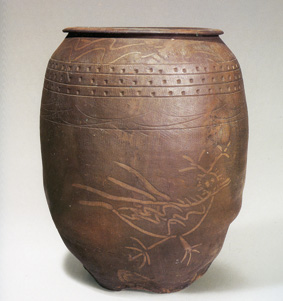

Pottery jars of different shapes point the empty spaces around the Ewha Womans University Museum with an eclectic palette of reds and yellows. These prehistoric jars are called onngi, and all those onngis are jumbled onngi-jongi (densly clustered) together.
Kim In-ho, a curator at the museum, said that onngi are a unique Korean tradition that mark Korea as having its roots in a third culture, different from the cultures of China or Japan.
“When the reporters from a newspaper in New York visited Ewha, they came to the museum to take a look at Korean relics. We showed them a lot of diverse things and among them, they pointed out the onngi as having a unique Korean taste and color,” said Kim.
Korea possesses with a proud legacy of ceramic art, the comb patterned pottery of the Neolithic Period (5,000 B.C.), continuing through the celadon porcelain of Goryeo and the white porcelain of the Chosun Dynasty, and even active in the techniques handed down to today. In the year 2000, the museum held an exhibition titled, “Korea’s Third Ceramic Tradition?from Earthenware to Onngi,” to show the significance of onngi as part of this tradition.
Although onngi sounds purely historic, there is no country house without onngi, as this technique is still used to make the large pots which store kimchi and other pickles.
The Ewha museum received many of its onngi from donations.
“Usually people in their 70s or 80s donate onngi when they move to apartments because they know that there onngi are not just old-fashioned pieces of dishware but a part of Korean tradition that they must share,” said Kim.
This flood of onngis, led the museum to display many of them outside. Kim pointed to an onngi jar with cock painting as the most peculiar. “This onngi is not only for practical use but also very attractive, with a lively painting of chicken posing to run somewhere,” said Kim.
There are many other onngi displayed near the museum. One looks like a typical pot with a bulging tummy. Another onngi, situated in the left corner of the veranda on the eastern corner of the veranda on the eastern corner of the museum, has a wide mouth and slim waist. That one was used to preserve salted shrimp, which were eaten a lot in the past in the Mapo area. Another onngi shaped like a huge ball bottle with a tiny top, exhibited a few steps away from the museum entrance, was used to carry water on Jeju Island. The tiny opening at the top is just big enough to drink or pour from, and prevented the water from spilling while it was carried around.

All similar, but with different characteristics, the Ewha museum’s onngis have found a new use decorating the museum’s spaces for the Ewha students who drop by. But with the beginning of winter and the advent of the season for preparing kimchi, new onngi are also coming into use all around Korea to carry on the ancient tradition.
유정은 기자
yje881004@ewhain.net

